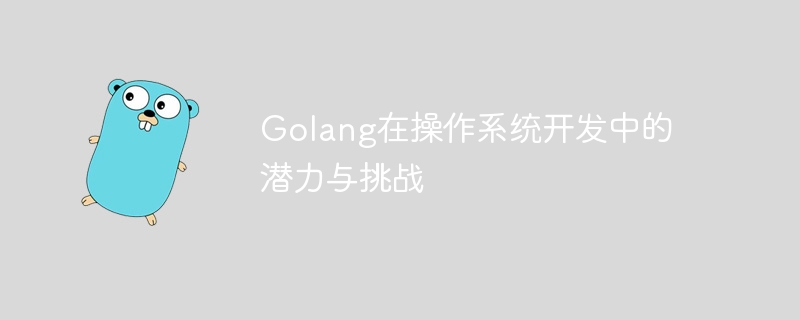Home >Backend Development >Golang >Golang's potential and challenges in operating system development
Golang's potential and challenges in operating system development
- WBOYWBOYWBOYWBOYWBOYWBOYWBOYWBOYWBOYWBOYWBOYWBOYWBOriginal
- 2024-03-21 08:45:041263browse

The potential and challenges of Golang in operating system development
In recent years, due to the efficiency and simplicity of Golang (Go language), More and more developers are beginning to apply it to various fields, including operating system development. As a compiled language with strong concurrency and excellent performance, Golang brings new possibilities to operating system development, but it also faces some challenges. This article will explore the potential and challenges of Golang in operating system development and provide some specific code examples.
1. The potential of Golang
1. Concurrency performance advantages
As a language with powerful concurrency, Golang has the concept of lightweight threads (goroutine), which can Easily implement efficient concurrent programming. In operating system development, a large number of concurrent tasks need to be processed, and Golang can provide good support. The following is a simple concurrency example:
package main
import (
"fmt"
"sync"
)
func main() {
var wg sync.WaitGroup
wg.Add(2)
go func() {
defer wg.Done()
//Here is the code for the first concurrent task
fmt.Println("Hello from goroutine 1")
}()
go func() {
defer wg.Done()
//Here is the code for the second concurrent task
fmt.Println("Hello from goroutine 2")
}()
wg.Wait()
}2. Performance Optimization
Golang performs well in terms of performance. Optimized Golang programs can achieve performance levels comparable to C/C programs. In operating system development, efficient code execution speed is required, and Golang can help developers achieve this goal. The following is a simple performance optimization example:
package main
import "fmt"
func main() {
const n = 1000000
var sum int
for i := 0; i < n; i {
sum = i
}
fmt.Println(sum)
}2. Challenges of Golang
1. There is less underlying support
Compared with traditional operating system development languages (such as C/C), Golang has The underlying operating system development support is relatively lacking. The implementation of some underlying operating system features may require the use of C language interfaces, which adds a certain degree of complexity. The following is an example using the C language interface:
package main
/*
#include <stdio.h>
void cFunction() {
printf("Hello from C function
");
}
*/
import "C"
func main() {
C.cFunction()
}2. Memory management challenges
In operating system development, memory management is crucial and needs to ensure efficiency and security. Golang's garbage collection mechanism may affect the real-time performance and stability of the operating system, so memory management issues need to be handled carefully. The following is an example of a memory management challenge:
package main
import "fmt"
func main() {
slice := make([]int, 1000000)
// A lot of memory allocation
// May trigger garbage collection
// ...
// Continue executing other code here
}Conclusion
Although Golang faces some challenges in operating system development, its powerful concurrency performance and performance optimization capabilities give it the potential to play an important role in operating system development. By demonstrating the application of Golang in operating system development in code examples, we can better understand Golang's unique advantages and challenges in this field. It is hoped that Golang can show greater potential in the field of operating system development in the future and bring more possibilities to technological innovation.
(Number of words: about 850 words)
The above is the detailed content of Golang's potential and challenges in operating system development. For more information, please follow other related articles on the PHP Chinese website!

